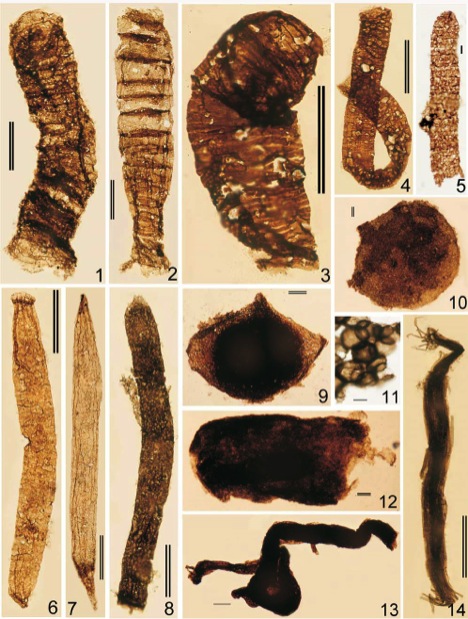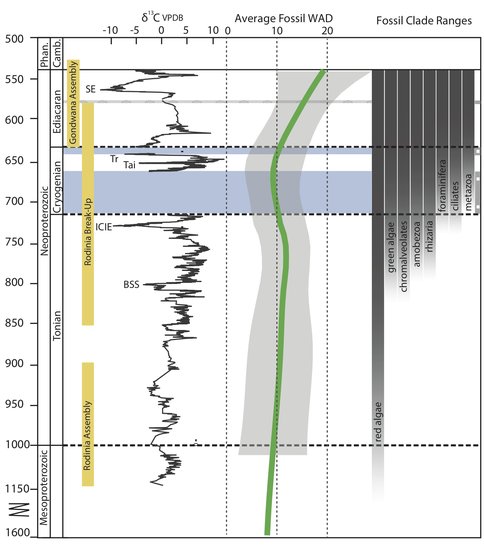2015 Annual Science Report
 Massachusetts Institute of Technology
Reporting | JAN 2015 – DEC 2015
Massachusetts Institute of Technology
Reporting | JAN 2015 – DEC 2015
Paleontological, Sedimentological, and Geochemical Investigations of the Mesoproterozoic-Neoproterozoic Transition
Project Summary
As we learn more about the earliest evolutionary history of animals and other complex multicellular organisms, it becomes clearer that a satisfactory understanding of these events have to be set within the broader context of late Mesoproterozoic and Neoproterozoic biological and environmental change. To this end, several labs within our team have focused research effort of Mesoproterozoic and Neoproterozoic sedimentary successions. Over the reporting period, this has included stratigraphic and sedimentological fieldwork on rocks of this age in northwestern Canada, Death Valley, Mongolia, Peru, and anaylsis of drill cores from Russia, Congo and Zambia. Progress has also been made in new techniques for the discovery, description, and interpretation of Proterozoic microfossils, and several-fold improvements in the precision of oxygen-17 measurements, which can record the balance of atmospheric oxygen and carbon dioxide.
Project Progress
The Macdonald lab lead NAI supported fieldwork on Neoproterozoic successions in Death Valley, CA, Mongolia, Peru, and the Yukon. Through this work, we discovered new fossils in Death Valley that suggest an extinction event of the Ediacaran fauna coincided with the Precambrian-Cambrian boundary and opened the door for the Cambrian Explosion of morphological diversity (Smith et al., in review). In Death Valley and the Yukon we also documented early Neoproterozoic envirnomental change and microfossil assemblages that immediately preceed the Sturtian Snowball Earth event (Smith et al., 2015; Strauss et al., 2015). These fossil assemblages appear to be distinct from post Snowball assemblages, yet in an analytical paleontological framework, there is little evidence for Neoproterozoic extinction or radiation events (Cohen & Macdonald, 2015).

Work in the Yukon also focused on assessing changes in oxygenation with the first appearances of macroscopic fossils (Sperling et al., 2015b). This work provided some of the samples for an Fe speciation database (Sperling et al., 2015a) and demonstrated that there was little relationship between oxygenation state and the appearance of fossils, but instead fossil appearance in the record seems to be largely taphonmically controlled (Sperling et al., 2015b; Cohen & Macdonald, 2015). In Mongolia we discovered new Cryogenian algae fossils (Cohen et al., 2015), and established a stratigraphic framework for Neoproterozoic successions (Bold et al., in press). Samples from Mongolia, the NW Canada, and cores from Zambia also provided the basis for generating a new age model for the Cryogenian Snowball Earth events (Rooney et al., 2015). Current work in the Yukon is creating a stratigraphic framework for the Mesoproterozoic-Neoproterozoic strata. Current work in Peru is descibing new Ediacaran successions that preserve the largest carbon isotope excursion in the geological record and aims to understand the origin of these perturbations to the carbon cycle and the relationship with biological diversification.
Work in the Johnston lab on the aftermath of the Marinoan glaciation provides new insight into the climate system. Reports of anomalous 17O values within cap carbonate hosted barites were restricted to South China and Mauritania. Through our work, we extend the 17O anomaly to northwest Canada with our new measurements of barites from the Ravensthroat cap dolostone with a minimum 17O value of −0.75 ‰. For the first time we pair triple oxygen with multiple sulfur isotopic data as a tool to identify the key processes that controlled the post-Marinoan sulfur cycle. We argue using a dynamic 1-box model that the observed isotopic trends both in northwest Canada and South China can be explained through the interplay between sulfide weathering, microbial sulfur cycling and pyrite burial. An important outcome of this study is a new constraint placed on the size of the post-Marinoan sulfate reservoir (≈0.1% modern), with a maximum concentration of less than 10% modern. Through conservative estimates of sulfate fluxes from sulfide weathering and under a small initial sulfate reservoir, we suggest that observed isotopic trends are the product of a dynamic sulfur cycle that saw both the addition and removal of the 17O anomaly over four to five turnovers of the post-Marinoan marine sulfate reservoir.
Knoll lab: We completed research on well preserved microfossils from ca. 1500 million year old rocks in Russia. Samples of carbonaceous shale from the Kaltasy Formation were collected from drill cores and processed in the lab for microfossils. Abudant and well preserved microfossils document 34 distinct biological entities, including problematic eukaryotes.
Ornamented microfossils found in coastal successions of other lower Mesoproterozoic basins are absent, but large filamentous microfossils interpreted as possible benthic photosynthetic eukaryotes are recorded, drawing comparisons to relatively deep water shales in Siberia. In overall aspect, the Kaltasy microfossils are consistent with other broadly coeval assemblages, but they highlight the importance of environment, as well as age, in determining the distributions of remains that record the early diversification of marine eukaryotes (Sergeev et al., 2015; a second, monogrpahic paper is currently in review). We also completed filed-based research on ca. 2400 millinoyear old carbonates from northwestern Australia, doucmenting distinctive stromatolites morphlogies at a time of large-scale environmental change — the Great Oxygenation Event. We contributed two reviews, one of early microbial evolution (Knoll, 2015) and one discussing the evolution of biomineralization by protists and its biogeochemical consequences (Knoll and Kotrc, 2015).
The Cohen lab, in collaboration with Francis Macdonald, published a major new analysis of the Proterozoic fossil record this year in the journal Paleobiology (Cohen and Macdonald 2015). This manuscript is a detailed compilation of all known Proterozoic eukaryotic fossils, analyzed in the context of stratigraphic, geochemical, and evolutionary datasets. This paper will set the stage for new research on eukaryotic evolution and the fossil record. Continuing research in the Cohen lab alongside undergraduate research assistants includes a detailed stratigraphic analysis of the Fifteenmile Apatitic Scale Microfossils to better understand controls on their preservation and further explore their morphology and taxonomic affinity. This work will ultimately help to reveal more about the evolution of biomineralization in this unique fossil group. We also continue our work on the taphonomy and taxonomy of vase-shaped microfossils (VSM) from the Callison Lake Formation of the Yukon to understand the controls on VSM diversity and preservation and their utility as biostratigraphic markers. In collaboration with graduate student Ross Anderson at Yale, we are working to better understand the stratigraphic distribution and taphonomic controls on agglutinated fossils and putative ciliates preserved in Mongolian carbonates during the Cryogenian glacial interlude.
Publications
-
Bradley, A. S., Leavitt, W. D., Schmidt, M., Knoll, A. H., Girguis, P. R., & Johnston, D. T. (2015). Patterns of sulfur isotope fractionation during microbial sulfate reduction. Geobiology, 14(1), 91–101. doi:10.1111/gbi.12149
-
Cohen, P. A., & MacDonald, F. A. (2015). The Proterozoic Record of Eukaryotes. Paleobiology, 41(04), 610–632. doi:10.1017/pab.2015.25
-
Cohen, P. A., MacDonald, F. A., Pruss, S., Matys, E., & Bosak, T. (2015). FOSSILS OF PUTATIVE MARINE ALGAE FROM THE CRYOGENIAN GLACIAL INTERLUDE OF MONGOLIA. PALAIOS, 30(3), 238–247. doi:10.2110/palo.2014.069
-
Knoll, A. H. (2015). Paleobiological Perspectives on Early Microbial Evolution. Cold Spring Harb Perspect Biol, 7(7), a018093. doi:10.1101/cshperspect.a018093
-
Kotrc, B., & Knoll, A. H. (2015). A morphospace of planktonic marine diatoms. I. Two views of disparity through time. Paleobiology, 41(01), 45–67. doi:10.1017/pab.2014.4
-
Kotrc, B., & Knoll, A. H. (2015). A morphospace of planktonic marine diatoms. II. Sampling standardization and spatial disparity partitioning. Paleobiology, 41(01), 68–88. doi:10.1017/pab.2014.5
-
Smith, E. F., MacDonald, F. A., Crowley, J. L., Hodgin, E. B., & Schrag, D. P. (2015). Tectonostratigraphic evolution of the c. 780-730 Ma Beck Spring Dolomite: Basin Formation in the core of Rodinia. Geological Society, London, Special Publications, 424(1), 213–239. doi:10.1144/sp424.6
-
Smith, E. F., MacDonald, F. A., Petach, T. A., Bold, U., & Schrag, D. P. (2015). Integrated stratigraphic, geochemical, and paleontological late Ediacaran to early Cambrian records from southwestern Mongolia. Geological Society of America Bulletin, 128(3-4), 442–468. doi:10.1130/b31248.1
-
Sperling, E. A., Carbone, C., Strauss, J. V., Johnston, D. T., Narbonne, G. M., & MacDonald, F. A. (2015). Oxygen, facies, and secular controls on the appearance of Cryogenian and Ediacaran body and trace fossils in the Mackenzie Mountains of northwestern Canada. Geological Society of America Bulletin, 128(3-4), 558–575. doi:10.1130/b31329.1
-
Sperling, E. A., Wolock, C. J., Morgan, A. S., Gill, B. C., Kunzmann, M., Halverson, G. P., … Johnston, D. T. (2015). Statistical analysis of iron geochemical data suggests limited late Proterozoic oxygenation. Nature, 523(7561), 451–454. doi:10.1038/nature14589
- Bold, U., Smith, E.F., Rooney, A.D., Bowring, S.A., Dudas, Dudás, F.Ö., Ramezani, J., Buchwaldt, R., Crowley, J.C., Schrag, D.P., and Macdonald, F.A., 2015. Neoproterozoic stratigraphy of the Zavkhan terrane of Mongolia: The backbone for Cryogenian and early Ediacaran chemostratigraphic records, American Journal of Science, in press.
- Knoll, A.H. and B. Kotrc (2015) Protistan skeletons: a geologic history of evolution and constraint. In: C. Hamm, ed., Evolution of Lightweight Structures. Springer-Verlag, Berlin, pp. 3-16.
- Kotrc, B. and A.H. Knoll (2015) Morphospaces and databases: The evolution of diatom shape and diversity through time. In: C. Hamm, ed., Evolution of Lightweight Structures. Springer-Verlag, Berlin, pp. 17-38.
- Martindale, R., J. Strauss, A.H. Knoll and others (2015) Sedimentology, chemostratigraphy and stromatolites of Lower Paleoproterozoic carbonates, Turee Creek Group, northwestern Australia. Precambrian Research 266: 194-211.
- Rooney, A.D., Strauss, J.V., Brandon, A.D., Macdonald, F.A., 2015. A Cryogenian Chronology: Two long-lasting, synchronous Neoproterozoic Snowball Earth glaciations, Geology, 43(5), p. 459-462
- Sergeev, V.N. N.G.Vorob’eva, A.H. Knoll (2015) Lower Riphean (early Mesoproterozoic) assemblages of the Kaltasa Formation, Cis-Urals area and the Kotuikan and Ust’-Il’ya formations, Anabar Uplift, Siberia and their relation to contemporaneous oldest palynoflora. Lethaea Rossica, Supplement 2, pp. 171-177. (In Russian).
- Smith, E.F., Nelson, L.L., Strange, M.A., Eyster, A.E., Schrag, D.P., and Macdonald, F.A., submitted. The last of the Ediacaran Biota: two exceptionally preserved body fossil assemblages at Mt. Dunfee, Nevada, Geology.
- Strauss, J.V., F.A. Macdonald, G.P. Halverson, D.P. Schrag, and A.H. Knoll (2015) Stratigraphic evolution of the Neoproterozoic Callison Lake Formation. American Journal of Science, in press
- Strauss, J.V., Macdonald, F.A., Halverson, G.P., Schrag, D.P., and Knoll, A.H., 2015. Litho-, chemo-, and tectono-stratigraphic evolution of the Neoproterozoic Callison Lake Formation: Linking the break-up of Rodinia to the Islay carbon isotope excursion, Amercian Journal of Science, in press.
-
PROJECT INVESTIGATORS:
-
PROJECT MEMBERS:
Roger Summons
Project Investigator
Uyanga Bold
Co-Investigator
Phoebe Cohen
Co-Investigator
Andrew Knoll
Co-Investigator
Alan Rooney
Co-Investigator
Emily Smith
Co-Investigator
Justin Strauss
Co-Investigator
Ben Cowie
Collaborator
Galen Halverson
Collaborator
David Johnston
Collaborator
Rowan Martindale
Collaborator
Vladimir Sergeev
Collaborator
Malcolm Walter
Collaborator
Ross Anderson
Graduate Student
Spencer Irvine
Undergraduate Student
-
RELATED OBJECTIVES:
Objective 4.1
Earth's early biosphere.
Objective 4.2
Production of complex life.
Objective 5.2
Co-evolution of microbial communities
Objective 6.1
Effects of environmental changes on microbial ecosystems

